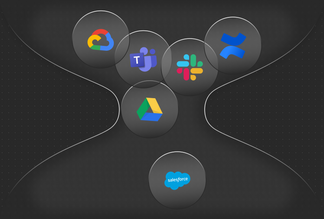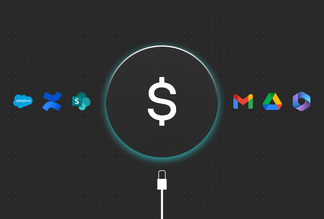

The definitive guide to asynchronous communication
I begin my workday by checking my Qatalog notifications at 8 a.m. in Dallas. Across the globe, it is 4 p.m. in Moscow, and Liliya is finalizing a keyword outline she’s been working on all day. She publishes an update to our Qatalog project, which shows up as a Slack notification in our #Marketing channel. Now I can begin to start a blog draft, but first I have some other things on my to-do list to take care of.
At Qatalog, we prioritize a healthy asynchronous environment because it allows us to collaborate across time zones. But we also prioritize async because it provides a more balanced way of working.
Our CMO, Evan, is located in New York. He’s only an hour ahead of me, and even though synchronous communication is available to us, we still rely on asynchronous methods because they provide more thorough documentation and context. Async allows me to maintain autonomy while still meeting communication expectations that are normal for a manager/employee relationship.
What is Asynchronous Communication?
Asynchronous communication is a situation where two or more persons can communicate without having to be available in real-time. That’s in contrast to synchronous communication, where you have to be available at that exact moment to share information from one person to another.
Asynchronous communication offers the ideal framework for remote teams who’re looking to engage team members across time zones, build consensus continuously, and empower team members to work with flexibility.
In this article, we’ll deconstruct asynchronous communication, touching on:
- What it’s not
- The benefits of asynchronous communication
- How to get it done right and
- A snapshot of the best asynchronous communication tools your team can start leveraging today
Benefits of asynchronous communication
Asynchronous communication gives your employees the flexibility they need to dive into deep work, removes hierarchical barriers that impact job perception, and removes the model of legacy work that today’s employees are trying to do away with. Moving to a majority asynchronous model not only allows your employees to take autonomy over their time, but it benefits the entire workforce — hybrid or not.
Thinking of the feedback loop, asynchronous communication puts time on your side and reduces the chance of emotionally-charged feedback and provides the ability to make critiques thoughtful and rich. It enforces a greater standard of transparency and honesty between employees, and in a remote organization that can only benefit trust in the long-term.
Over time, these factors deepen team thoughtfulness and quality of documentation, giving you a more detailed company history and compounding talent of each team member — who have now given you endless resources to prioritize autonomy.
1. Eliminates the pressure of synchrony
If you’ve ever woken up in the morning only to quickly hop on Zoom for a meeting you’re already late to, you’re not alone.
It’s not that meetings like this are inherently bad, either. Sync communication is necessary to balance an async model. But it does become a problem when you’re rolling out of bed unprepared for a recurring meeting without an agenda.
Over time, disregarding other team members’ schedules and personal lives decreases trust and impacts retention. Forcing your west coast employee (hi Nae👋) to be up at 6 a.m. every day will certainly impact the likelihood of them enjoying their workday (unless they’re a morning person), and we also don’t want to keep Liliya up until midnight.
On the other hand, asynchronous communication removes the need to be present at every moment so that team members can work at their own pace and find a cadence that helps them maximize productivity.
2. Frees up time for deep work & boosts productivity
One of the big perks of asynchronous communication is that it puts everyone in charge of their calendar. And that’s when you can finally mark off specific hours for deep work — when you’re not getting pulled in standups, briefings, and calls every half hour.
Anecdotally, many remote workers still feel as though there is the pressure to signal they’re still alive. And that pressure exists for managers too, who are used to having a direct feedback loop from their team.
Asynchronous communication, especially when paired with remote work, creates a culture of responsibility where outcomes are valued over time spent online. Calendar holds for deep work are encouraged, meetings can be shifted to updates over Slack or posts within your work hub. And more importantly, this creates a culture of respect and trust that everyone is working at full capacity.
There’s a way to add a layer of transparency to every outcome of your workday, but we’ll get to that in a minute.
3. Improves the quality of your comms
Take a look at the last 10 emails you sent out to your coworkers. How many of these lack documentation and context? If you dive into Slack, where do you begin searching for status updates or goal progress? We know it's there, it’s just buried under a lot of other conversations. Or, if you’re scrolling through my Slack, you’ll find an embarrassing amount of gifs.
When members of a team are free to assimilate information and build a thorough response to it before replying, quality improves drastically. Team members are essentially putting down their thoughts with more detail, more context, and more information than they ever would if they were shooting off emails just six seconds after reading them. An async model removes the pressure to reply now.
4. A culture of documentation
Asynchronous communication creates a culture where information that you create today can be reused tomorrow, or sometime in the future.
When you’re approaching communication from an asynchronous standpoint, team members put more substance into their communications, making it a reliable knowledge base.
For example, if a coworker had to brief a project, that document would have to contain a lot of context including:
- Reason why we're doing this now
- Who's on the project and stakeholders
- Project milestones and timelines
A good document is a concise set of information that addresses any frequently asked questions. It buys others into your project or the work that needs to be done, and helps to get your team excited about the initiative.
Read more: The hottest trend in corporate culture is documentation
5. Ideal for remote teams that may be scattered across diverse timezones
Remote work is the new normal, with up to 40% of remote workers looking to quit their jobs for opportunities that let them work flexibly.
At the center of it all is asynchronous communication. Working asynchronously, employees scattered across diverse time zones can communicate with colleagues from across the globe, build consensus, collaborate on projects, and generally get 25% more work done than their on-site colleagues.
How to get asynchronous communications right
Switching to asynchronous communication isn’t as simple as just signing up for a few apps and asking everyone on your team to use them. Rather, asynchronous communication is more of a culture of respecting everyone’s time and setting expectations of timelines and information quality.
Set expectations
To get asynchronous communication right, you need to set definite expectations regarding your communication cadence.
Many remote-friendly organizations, like Doist and InVision, have communication charters that are woven into employee onboarding. These charters contain rules of communication for different channels, since obviously our preferences shift between instant messaging, sending emails, and leaving comments in a project management doc.
Sitting down to create a charter with your leadership team should be actionable takeaway number one of this article. For a team to prioritize a healthy async workplace that doesn’t slip back into sync expectations, you have to set the standard of communication.
One strategy that could help would be setting time windows for messaging, within which employees are required to assess and reply to whatever messages are in their inbox, to ensure the sender isn’t kept waiting indefinitely.
Again, asynchronous communication emphasizes freedom and flexibility, a strong culture that defines expectations will be required to hold it all together.
Over-communicate — deliberately
Without the real-time flow of synchronous communication, the only way asynchronous communication can measure up is with context.
This means putting more information into writing or recording so that it goes above and beyond meeting the needs of the receiver.
And without a strong emphasis on over-communicating, an asynchronous model will end up as just another shortcut to skimp on communications, and eventually, you’ll have to revert to real-time communication to make up for the shortcoming.
What do you communicate? Context on a project, processes, goals, and people.
Channels to implement asynchronous communication + the best asynchronous communication tools
There are several channels where you can adopt an asynchronous communication culture to help you accelerate your transition from real-time communication.
Chat: Chat is a natural interface that promotes asynchronous communication since you get your communications stored for the long-term and you don’t have to reply at the moment. Some of the best asynchronous chat tools include Slack, Rocket, Chanty, Mattermost, and Microsoft Teams.
Video: Tools like Loom, Prezi, and Supernormal promote async video platforms that team members can use to record and share videos, screen recordings, etc., as the need arises, without having to engage with colleagues in real-time using a tool like Zoom.
Audio: Asynchronous audio focuses on recording, sharing, and storing audio files. Yac, Around, Presence, and Spokn are all focused on building an asynchronous audio platform where users can drop in and reply flexibly vs. being available constantly.
How to make asynchronous communication work for your team: The culture factor
While it can be tempting to sign up for every new collaboration application, that’s not really what you need to build a flexible workplace where team members are free to collaborate without disturbing theirs or anyone’s flow.
Asynchronous communication focuses on maintaining a culture of accountability where people can get work done without being in sync every moment of the day, or checking in to some overseer to report every single milestone.
Traditional sync workplace cultures are made of supervised, rigid schedules. While async is more characterized by flexible, focused, and trust-based teams.
Read more: How to build an asynchronous culture in 12 steps
Qatalog is the home for your entire workspace: synchronous & asynchronous
We designed Qatalog as the ultimate asynchronous communication platform where you can:
- Align team members on goals, tracked end-to-end
- Pinpoint files, messages, and even lines of code from across the tens of SaaS apps you already use
- Automate processes across tools with powerful workflows
- Reach the right people within your organization with the right message using a solution tailored to your needs, well beyond the limitations of traditional intranets
- Enhance deep work with one source of truth & less context switching
- Centralize all your work so you can group people and their activities into one powerful digital workplace
Whether you’re remote, in-office, or a hybrid organization, Qatalog offers the one source of truth where you can manage all your work, collaborate flexibly, and still hit deadlines.


